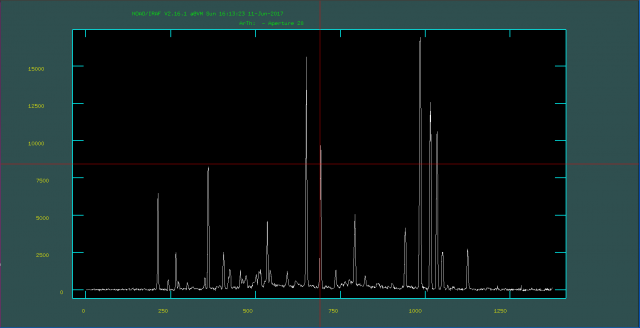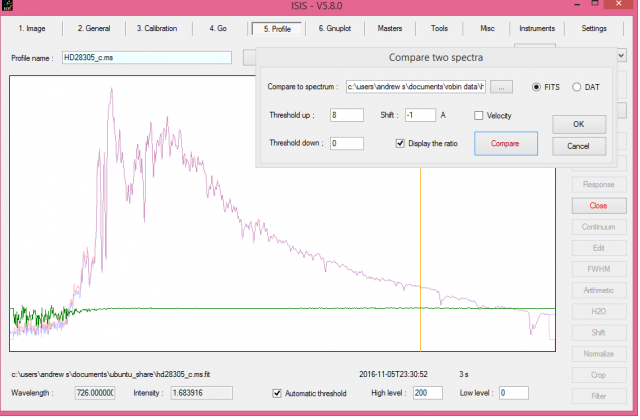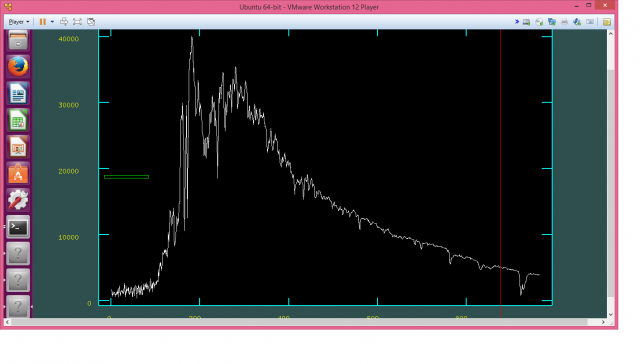Forum Replies Created
-
AuthorPosts
-
 Dr Andrew SmithParticipant
Dr Andrew SmithParticipantHi Paul, sorry no documentation as such but the layout is similar to the Shelyak Eshel and I use their fiber guide head. It has a different l/mm and larger grating which is why I went the IRAF route as I could not get ISIS to reduce the spectra.
There is some information here http://www.spectro-aras.com/forum/viewtopic.php?f=8&t=1458 and here http://forum.vdsastro.de/viewtopic.php?f=28&t=4449
If you have any specific questions I will be happy to respond.
On IRAF while it has been a learning curve I have been able to completely script the image calibration so all I need type, once in IRAF, is cl < CalMRes.cl and once I have completed the data reduction of the spectra I should be able to do the same. Although it is good to eyeball the images and check the image statistics which are both simple in ds9 and IRAF.
IRAF stores all the key data so you can simply reproduce the reduction as long as the spectrograph stay reasonably stable as small shifts can be automatically compensated for.
As I will have three spectrographs (two echelles and one low res transmission grating) I can have 3 IRAF folders each dedicated to a particular spectrograph.
If you have any specific question I would be happy to answer them if I can.
Regards Andrew
 Dr Andrew SmithParticipant
Dr Andrew SmithParticipantWell after considerable procrastination on my part and with the help of the kind souls on the SPEKTROSKOPIE forum I have finally managed to extract 28 orders from my echelle spectrograms using IRAF. They are as yet un-calibrated in wavelength as I still need complete the mapping of the Th Ar lines to the orders ( more procrastination on my part).
I ran into one last obstacle when the spectral extraction crashed with an error “Polynomial separation too large” . Google only led to a very few links but I managed to hunt down a hidden parameter “polysep” and a reference to lowering it and by chance a hint to where it could be found. Changing it fortunately fixed the problem… …phew.
The attached is the Th Ar spectrum from order 51 and matches that I got from Bass.
Regards Andrew

 Dr Andrew SmithParticipant
Dr Andrew SmithParticipantWell done John. I am still interested in feedback especially if you found any problems with my instructions.
I am working through reducing my echelle spectra. Various things have delayed this but I need to now just get on and crash through it having tried the various tutorials.
One of the delaying activities was learning to use Python with ANACONDA as the I could not open the multi-spectra FITS format with the standard amateur tools (ISIS etc.) this is not an issue with standard slit spectra. I also used Python to complete fully automating the collection of echelle spectra!
Regards Andrew
 Dr Andrew SmithParticipant
Dr Andrew SmithParticipantGary and Andy you are now expelled for discussing the unmentionable!
 Dr Andrew SmithParticipant
Dr Andrew SmithParticipantYes Andy I am making progress. I am using astropy on Windows in a very amateur manner.
Nonetheless,I have managed to extract the first of the test spectra from the multispec format and saved it in a form that ISIS will open and display correctly. It helped when I opened the .FITS file in ‘update’ mode then I could add the extra header data. Just need to put it in a loop to get all the orders out and tidy up the header data. (Tim Lester’s PlotSpectra currently objects to the date and time format!) I will need to read the BSS spec carefully.
Regards Andrew
 Dr Andrew SmithParticipant
Dr Andrew SmithParticipantThanks Robin I have asked there and Otmar has responded. He proposed an IRAF method I had already tried but it seems ISIS did not like the 1D result. It could have been a specific issue with the data I had.
In any even I have cracked the key issues in getting a Python program to read the data so I can write it out in an acceptable FITS format. Just need to complete the program and test it out.
Thanks for the advice.
Regards Andrew
 Dr Andrew SmithParticipant
Dr Andrew SmithParticipantAndy leave it with me. I would benefit from fixing it myself so I can use other tools.
Regards Andrew
 Dr Andrew SmithParticipant
Dr Andrew SmithParticipantI would not assume it is bad guiding John. Bad guiding can be a benefit as the whole of the stars PSF gets sampled (more or less) while good guiding may just sample the brightest (often green) part of the spectrum as seen in the guide camera. The narrower the slit the more this becomes true!
Regards Andrew
 Dr Andrew SmithParticipant
Dr Andrew SmithParticipantJust a bit to high for my R ~ 9000 echelle. I am not sure I will finish the R ~ 20000 in time but if I do I will join in. I am sure some LHires III users will join you.
Regards Andrew
 Dr Andrew SmithParticipant
Dr Andrew SmithParticipantHi Ernst, nice idea not that I have tried observations in August before as it never gets really dark.
What is the minimum resolution required and how often are spectra needed?
Thanks Andrew
 Dr Andrew SmithParticipant
Dr Andrew SmithParticipantUsing AOD seems to me to be like trying to do absolute photometry in that a) you know the value to set the AOD at and b) it is constant across the sky and not time dependent. I imagine a value of AOD can be estimated from a single reference star I am not clear how the potential variation across the sky and with time is managed unless a series of standard stars has been observed throughout the night.
Has any one tried this for a set of reference stars? It would be good to see some data to allow a judgement to be made.
I think it is accepted that, at least in the UK, photometric quality nights are few and far between.
Regards Andrew
 Dr Andrew SmithParticipant
Dr Andrew SmithParticipantI think it is quite common for there to be several “options” for the spectral class. It seems that it is as much art as science to the process. The VizeirR access to Catalogue of Stellar Spectral Classifications (Skiff, 2009-2016) is where I always go.
Regards Andrew
 Dr Andrew SmithParticipant
Dr Andrew SmithParticipantBy processing Robin’s HD28305 data in ISIS without either calibration or instrument correction I managed to directly compare the result I got from IRAF. It shows they are in effect (and as one would expect) identical apart from small differences at the short wavelength end where my decision not to use a dark in IRAF is amplified by the flat correction. (As I understand it the 1 pixel shift in ISIS is well known)
This give me confidence in using IRAF and to make the next steps in wavelength calibration and then on to echelle spectra.
Regards Andrew

 Dr Andrew SmithParticipant
Dr Andrew SmithParticipant Following the tutorial at http://www.twilightlandscapes.com/IRAFtutorial/ I have managed to extract a spectrum from Robins data on HD28305. I still have to calibrate it and there is no instrument response.
Following the tutorial at http://www.twilightlandscapes.com/IRAFtutorial/ I have managed to extract a spectrum from Robins data on HD28305. I still have to calibrate it and there is no instrument response.The tutorial uses some basic function rather the more complex ones so it has been good for learning what is going on.
The extracted profile would display in ISIS so moving between the packages should be quite possible.
The IRAF package is good at displaying image statistics and for these short exposures the bias and flat frame were not statistically different apart from the hot pixels so I just used the bias frames.
 Dr Andrew SmithParticipant
Dr Andrew SmithParticipantThank you both for sharing your data. They make a good contrasting pair. I will update you as (if) I make progress.
Interestingly Paul, I have yet to see a reference to tellurics in the documentation – not that I have looked for it.
Thanks again to both of you. I think I have enough data now and I even managed a clearish night two nights ago so have some new echelle data to ponder from a standard RV star and the yellow hypergiant Rho Cass.
Regards Andrew
 Dr Andrew SmithParticipant
Dr Andrew SmithParticipantThanks for the data Robin and full marks for the analysis you did on the Aply.
Regards Andrew
 Dr Andrew SmithParticipant
Dr Andrew SmithParticipantHi Robin, would you be willing to share a standard set with your normal spectral flats. The bad pixel removal is a final optional step and I am itching to get going?
IRAF uses different approaches to ISIS for both long-slit and echelle spectral extraction. It looks like the pros use both “dome” and sky/twilight flats rather than a prnu flat. As an example of the different approaches IRAF calibrates each “row” along the dispersion axis first, hence removing smile without a pixel by pixel translation, then does the extraction.
Regards Andrew
PS Anyone else willing to share some data with or without the two sets of spectral flats?
 Dr Andrew SmithParticipant
Dr Andrew SmithParticipantHi Robin, thanks for the offer of help. I would certainly need conventional spectroscopic flats. Looking at the documentation what it seems to be doing is comparing the values of the pixels between the two flats and their exposure to see which are obviously non linear. So I think either spectroscopic or normal imaging flats will do provided they differ in intensity pixel by pixel by a factor of 10 or so after bias subtraction and are not saturated.
Regards Andrew
 Dr Andrew SmithParticipant
Dr Andrew SmithParticipantHi Robin, I might have known you would have IRAF! I see the command line as no big issue. You soon get used to it and once you know what you are doing you can automate the process via scripts which minimises the typing.
Regards Andrew
PS If you use the C Buil convention of file name like Spectra-1.fit you need to get rid of the “-” as IRAF may try to subtract the two files Spectra and 1.fit! I now use underscore “_”.
 Dr Andrew SmithParticipant
Dr Andrew SmithParticipantGrant, simple answer is I don’t known. I have only come across command line driven but it uses graphical windows for certain tasks. Maybe some some IRAF experts will know.
For my task I was trying to use the most basic approach possible.
Regards Andrew
-
AuthorPosts
